Potrebujeme váš súhlas na využitie jednotlivých dát, aby sa vám okrem iného mohli ukazovať informácie týkajúce sa vašich záujmov. Súhlas udelíte kliknutím na tlačidlo „OK“.
ASTM D1633-00(2007)
Standard Test Methods for Compressive Strength of Molded Soil-Cement Cylinders (Withdrawn 2016)
Automaticky preložený názov:
Štandardné Skúšobné metódy pre pevnosť v tlaku z lisovaného Soil, cement vojne
NORMA vydaná dňa 1.2.2007
Informácie o norme:
Označenie normy: ASTM D1633-00(2007)
Poznámka: NEPLATNÁ
Dátum vydania normy: 1.2.2007
Kód tovaru: NS-17897
Počet strán: 4
Približná hmotnosť: 12 g (0.03 libier)
Krajina: Americká technická norma
Kategória: Technické normy ASTM
Kategórie - podobné normy:
Zemní práce. Hloubicí práce. Budování základů. Podzemní práce
Anotácia textu normy ASTM D1633-00(2007) :
Keywords:
compressive strength, soil-cement, soil stabilization, ICS Number Code 93.020 (Earth works. Excavations. Foundation construction. Underground works)
Doplňujúce informácie
| Significance and Use | ||||||||||||||||||||
|
Method A makes use of the same compaction equipment and molds commonly available in soil laboratories and used for other soil-cement tests. It is considered that Method A gives a relative measure of strength rather than a rigorous determination of compressive strength. Because of the lesser height to diameter ratio (1.15) of the cylinders, the compressive strength determined by Method A will normally be greater than that for Method B. Method B, because of the greater height to diameter ratio (2.00), gives a better measure of compressive strength from a technical viewpoint since it reduces complex stress conditions that may occur during the shearing of Method A specimens. In practice, Method A has been more commonly used than Method B. As a result, it has been customary to evaluate or specify compressive strength values as determined by Method A. A factor for converting compressive strength values based on height to diameter ratio is given in Section 8.3 Note 1—The agency performing this test method can be evaluated in accordance with Practice D 3740. Not withstanding statements on precision and bias contained in this test method: the precision of this test method is dependent on the competence of the personnel performing it and the suitability of the equipment and facilities used. Agencies that meet the criteria of Practice D 3740 are generally considered capable of competent and objective testing. Users of this test method are cautioned that compliance with Practice D 3740 does not, in itself, ensure reliable testing. Reliable testing depends on many factors; Practice D 3740 provides a means of evaluating some of these factors. |
||||||||||||||||||||
| 1. Scope | ||||||||||||||||||||
|
1.1 This test method covers the determination of the compressive strength of soil-cement using molded cylinders as test specimens. 1.2 Two alternative procedures are provided as follows: 1.2.1 Method A - This procedure uses a test specimen 4.0 in. (101.6 mm) in diameter and 4.584 in. (116.4 mm) in height. Height to diameter ratio equals 1.15. This test method made be used only on materials with 30 % or less retained on the 3/4-in. (19.0-mm) sieve. See Note 3. 1.2.2 Method B - This procedure uses a test specimen 2.8 in. (71.1 mm) in diameter and 5.6 in. (142.2 mm) in height. Height to diameter ratio equals 2.00. This test method is applicable to those materials that pass the No. 4 (4.75-mm) sieve. 1.3 All observed and calculated values shall conform to the guidelines for significant digits and rounding established in Practice D 6026. 1.4 The values stated in inch-pound units are to be regarded as standard, except as noted in 1.4.1-1.4.3. The values given in parentheses are mathematical conversions to SI units, and are provided for information only and are not considered standard. 1.4.1 The gravitational system of inch-pound units is used when dealing with inch-pound units. In this system, the pound (lbf) represents a unit of force (weight), while the unit for mass is slugs. 1.4.2 The slug unit of mass is almost never used in commercial practice (density, scales, balances, etc.). Therefore, the standard unit for mass in this standard is either kilogram (kg) or gram (g), or both. Also, the equivalent inch-pound unit (slug) is not given. 1.4.3 It is common practice in the engineering/construction profession in the United States to use concurrently pounds to represent both a unit of mass (lbm) and of force (lbf). This use combines two separate system of units, the absolute system and the gravitational system. It is scientifically undesirable to combine the use of two separate sets of inch-pound units within a single standard. As stated in 1.4.2, this standard uses the gravitational system and does not present the slug unit for mass. However, the use of scales or balances recording pounds of mass (lbm) or the recording of density in lbm/ft3 shall not be regarded as nonconformance with this standard. This standard does not purport to address all of the safety concerns, if any, associated with its use. It is the responsibility of the user of this standard to establish appropriate safety and health practices and determine the applicability of regulatory limitations prior to use. |
||||||||||||||||||||
| 2. Referenced Documents | ||||||||||||||||||||
|
Podobné normy:
Historická
1.1.2012
Historická
1.2.2008
Historická
1.2.2006
Historická
1.2.2006
Historická
15.1.2010
Historická
1.10.2009


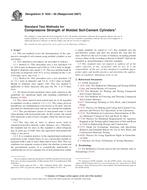
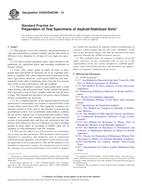 ASTM D4223/D4223M-12..
ASTM D4223/D4223M-12.. ASTM D425-88(2008)..
ASTM D425-88(2008).. ASTM D4253-00(2006)..
ASTM D4253-00(2006)..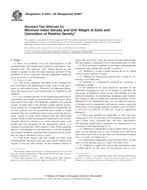 ASTM D4254-00(2006)e..
ASTM D4254-00(2006)e..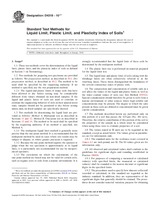 ASTM D4318-10e1
ASTM D4318-10e1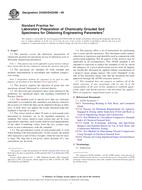 ASTM D4320/D4320M-09..
ASTM D4320/D4320M-09..
 Cookies
Cookies
